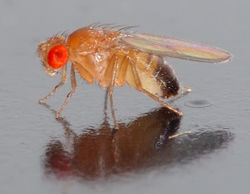HOMOLOGY(%)
HOMOLOGY(%)






Kua is a recently identified pseudogene located in chromosome 20. There is little information about this gene due to the fact that it was discovered in the early 2000. The Kua proteins seem to represent a novel class of conserved proteins with juxtamembrane histidine-rich motifs. What is known and proved is that the co-transcription of this gene and the neighboring downstream gene generates the rare transcript Kua-UEV.
The gene is located in q13.2 in chr20, upstream of the gene UBE2V1. It only has one known transcript:

Transcript 1:
There is a high level of conservation between the different orthologues in the different species. The percentage of homology descends when the species are more philogenetically separated. Table data from NCBI:
| IMAGE | SPECIE | GENE | PROTEIN
HOMOLOGY(%) |
DNA
HOMOLOGY(%) |
 |
C. familiaris | LOC611401 | 98.3% | 96.4% |
 |
M. musculus | AI840826 | 93.3% | 88.5% |
 |
R. norvergicus | Kua | 92.3% | 88% |
 |
G. gallus | LOC419350 | 76.5% | 69% |
 |
D. melanogaster | AT1G23260 | 60% | 58.7% |
 |
C. elegans | 10642 | 60% | 54.6% |
Furthermore, a phylogenetic tree was made with the protein sequence (from NCBI) of five different species using the program CLUSTALW. The tree obtained shows a correct phylogeny relation between species. This means that protein has been conserved throughout evolution.

In order to characterize the gene expression in human cell types and tissues, some miroarray chips from UCSC Genome Browser have been analyzed. The figures show the ratios of the normal human tissue cDNA microarrays experiment, where red colour indicates the gene is highly expressed in the tissue and green that it is underexpressed.
Normal Human Tissue cDNA Microarrays

According to the data from the microchip atlas at UCSC, the gene Kua is highly expressed in blood
cells such as NK cells or monocytes and myeloid tissues.
There is also certain evidence of high expression in the respiratory system like lungs and bronchial epithelial cells.
In the remaining tissues and cell types it has a normal expression rate, except in central neural system, bones and
skeletal muscle, where it seems to be underexpressed.
Unknown function due to the fact that it is a newly discovered gene. The only known function is to locate UBE2V1 in cytoplasm by adding an extra domain (domain B). It mantains the UBE2V1 function, but it changes its localization.
The promoter region and the transcription factors for Kua are the same as the ones for the co-expression of Kua-UBE2V1. Therefore, this part of the results can be seen in the Kua-UBE2V1 section.